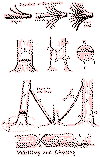by Ernest Thompson Seton
If I were marooned on an island or left alone in the wilderness, and had the choice of but one weapon to take along, I should take a good knife. If I were allowed two, the second would be a hatchet.
With these two one can make most of the things needed for securing food or building shelters.
The Northern Indians are probably the best whittlers in the world. They use a curious curved knife called the crooked knife. It is made of an old file curled up at the point so it can cut a narrow groove. With such a knife a Chipewyan Indian can make bow, arrows, traps, snowshoes, canoe, and wigwam--as well as clothing, his whole outfit complete; a good crooked knife, therefore, is a fair start in life for an industrious Indian.
Rules for Using a Knife
In whittling, always assume that the knife is going to slip, therefore, arrange so it can do no damage when it does slip.
For this reason, it is usual to make a beginner whittle away from himself, but that is not always safe. Indeed, all the best whittlers in the world, including Northern Indians, Farriers, Wagon-makers, etc., whittle toward themselves, with the hand held palm up, the knife blade at the little finger side, using the pull of the arm instead of the push, thereby getting more power and better control. But this is sure, you should never whittle toward the hand that is holding the wood.
Always keep your knife sharp. It is a sign of a tenderfoot to have a dull knife, and of a trained Woodcrafter to have a keen one.
To keep a knife sharp, it must be a good piece of steel and you must know how to sharpen it. The only way to get a good blade is to go to a good maker and pay a good price. The fancy knives that are corkscrew, tool chest, bootjack, and whistle all combined, are seldom of good steel.
Old-timers prefer a white-handled knife as it is more readily found if dropped on the ground or in the water.
The blade cannot be kept in good condition if used for anything but a wood cutter. Therefore, do not cut nails, metal, or softwood knots (especially hemlock knots) with it.
Never stick the blade in the fire. That would draw the temper and spoil the knife.
Do not abuse your knife by using it for a hammer, wedge, screwdriver, or pry.
Carry a little whetstone or else a small file to keep your knife in good shape.
A pocket or shut-up knife is the only style worth carrying. The hunting knife or dagger has not enough use to-day to make it worth while.
It is a proof of a good whittler if one can make half a dozen firefighters in succession. A firefighter or fuzz-stick (see above illustration) is a stick of soft wood about an inch thick or six or eight inches through, shaved into thin slivers which are still on the stick; that is, are one solid piece at one end and all thin slivers at the other. This can only be done if you have a sharp, strong knife, a well-selected piece of soft wood without knots in it, and a steady hand. Provided the wood is good, the firefighter is perfect if not a sliver is loose or drops off.
Use of Hatchet
A good camper is known by his hatchet; if it is always sharp, and kept muzzled when traveling, the owner knows his business.
Most of the knife rules apply equally to the hatchet.
Never try to break a stone with a hatchet or let the hatchet be driven into a log by striking its back with another hatchet or anything of metal; use a wooden maul if it is necessary to drive the hatchet, as in splitting a stick.
If you are going to hew a piece of timber with a hatchet, ways draw a line first to guide you.
If you are going to point a stake, make it a four-sided point, fitting sides No. 1 and No. 3, No. 2 and No. 4; so that finally ay any cross-section of the point it will be square.
It is a sure sign of inexperience when a camper throws his hatchet at trees, etc., to see if he can make it stick. Broken blades, broken handles, and injured trees are the inevitable result, with the large possibility of serious accident.
